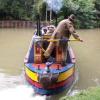As I would expect that is much very sensible input from Tony.
If the set-up has previously had 2 skin tanks but now has only one in use, that rings alarm bells to me that the single skin tank is insufficient to properly cool the engine, an that the original intention was to have both.
Contrary to what many people often incorrectly say, you can't have too big a skin tank, as long as the right thermostat is present and working. With just the large skin tank the engine would likely be "over-cooled", but the thermostat will control flow to the skin tank, and will only allow hot water through when at skin tank temperature.
We need to know dimensions of the skin tank that is in use. If any of the hose connections to it are in the "edge", it may be possible to push a rod in, and see if it comes up against anything solid - if it does there are probably at least some baffles. Baffles are usually horizontal, but can sometimes be vertical, so the "push a rod in" test only proves anything if it comes up against anything. Failure to do so doesn't necessarily mean "no baffles", as tghe rod and the baffles may be parallel to each other, with the rod passing between baffles, and not "finding" them.
But let's have the dimensions first.
Is there any possibility this boat was built by either Mike Heywood, or Evans and Son, as they have a reputation for boats with very inadequate skin tanks?




